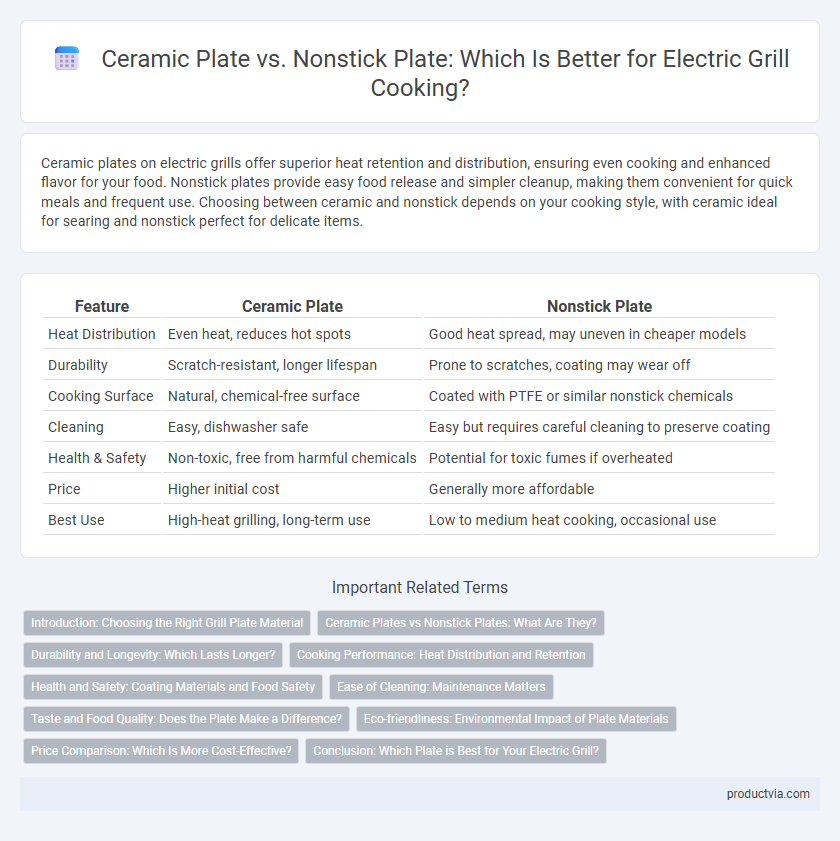Ceramic plates on electric grills offer superior heat retention and distribution, ensuring even cooking and enhanced flavor for your food. Nonstick plates provide easy food release and simpler cleanup, making them convenient for quick meals and frequent use. Choosing between ceramic and nonstick depends on your cooking style, with ceramic ideal for searing and nonstick perfect for delicate items.
Table of Comparison
| Feature | Ceramic Plate | Nonstick Plate |
|---|---|---|
| Heat Distribution | Even heat, reduces hot spots | Good heat spread, may uneven in cheaper models |
| Durability | Scratch-resistant, longer lifespan | Prone to scratches, coating may wear off |
| Cooking Surface | Natural, chemical-free surface | Coated with PTFE or similar nonstick chemicals |
| Cleaning | Easy, dishwasher safe | Easy but requires careful cleaning to preserve coating |
| Health & Safety | Non-toxic, free from harmful chemicals | Potential for toxic fumes if overheated |
| Price | Higher initial cost | Generally more affordable |
| Best Use | High-heat grilling, long-term use | Low to medium heat cooking, occasional use |
Introduction: Choosing the Right Grill Plate Material
Ceramic plates offer excellent heat retention and even cooking, making them ideal for electric grills where consistent temperature is crucial for grilling performance. Nonstick plates provide effortless food release and easier cleaning, enhancing convenience without the need for excess oil. Selecting between ceramic and nonstick depends on user preference for durability, cooking style, and maintenance priorities.
Ceramic Plates vs Nonstick Plates: What Are They?
Ceramic plates for electric grills are made from natural materials and coated with a non-toxic, durable ceramic layer that provides excellent heat distribution and scratch resistance without harmful chemicals. Nonstick plates typically feature a synthetic Teflon or PTFE coating that offers easy food release and quick cleaning but can degrade under high heat and release toxins if damaged. Choosing between ceramic and nonstick plates depends on prioritizing health safety, heat tolerance, and longevity in electric grill cooking.
Durability and Longevity: Which Lasts Longer?
Ceramic plates for electric grills offer superior durability due to their resistance to scratches and high temperatures, maintaining performance over extended use. Nonstick plates, while initially effective in preventing food from sticking, tend to degrade faster as the coating wears off with frequent exposure to heat and metal utensils. Choosing ceramic plates enhances longevity and consistent cooking quality, making them a more durable option for electric grill enthusiasts.
Cooking Performance: Heat Distribution and Retention
Ceramic plates on electric grills provide superior heat distribution and retention, ensuring even cooking and preventing hot spots that can cause food to burn or undercook. Nonstick plates offer a quick heat-up time but often suffer from uneven heat distribution, which can result in inconsistent cooking results. The durable ceramic surface maintains steady temperatures longer, enhancing the grilling experience and delivering uniformly cooked meals.
Health and Safety: Coating Materials and Food Safety
Ceramic plates for electric grills offer a non-toxic cooking surface free from harmful chemicals such as PFOA and PTFE, reducing the risk of toxic fumes at high temperatures. Nonstick plates commonly contain synthetic coatings that may degrade or release fumes when overheated, potentially impacting food safety and user health. Choosing ceramic ensures safer cooking due to its natural, durable, and chemical-free coating that promotes health-conscious grilling.
Ease of Cleaning: Maintenance Matters
Ceramic plates on electric grills offer superior ease of cleaning due to their non-porous surface, which resists food sticking and prevents grease absorption. Nonstick plates, while also designed to minimize sticking, may degrade faster with abrasive cleaning, requiring more delicate maintenance to preserve the coating. Choosing ceramic plates reduces cleanup time and enhances grill longevity, making them ideal for frequent cooks prioritizing hassle-free maintenance.
Taste and Food Quality: Does the Plate Make a Difference?
Ceramic plates in electric grills offer superior heat distribution and retention, enhancing the Maillard reaction for richer flavor and better texture in grilled foods. Nonstick plates prevent food from sticking, ensuring easier cleanup but may produce less consistent browning and aroma compared to ceramic surfaces. The ceramic coating's ability to reach higher temperatures often results in improved food quality by sealing juices and creating a crispy exterior.
Eco-friendliness: Environmental Impact of Plate Materials
Ceramic plates for electric grills offer superior eco-friendliness due to their non-toxic, chemical-free composition and longer lifespan, reducing waste and harmful emissions during production and disposal. Nonstick plates typically contain synthetic coatings like PTFE, which may release toxic fumes at high temperatures and involve environmentally damaging manufacturing processes. Opting for ceramic plates supports sustainability by minimizing environmental impact and promoting safer cooking surfaces.
Price Comparison: Which Is More Cost-Effective?
Ceramic plates for electric grills typically cost more upfront due to their durable, non-toxic coating and superior heat retention, making them a longer-lasting investment. Nonstick plates are generally cheaper but may require more frequent replacement due to coating wear and potential health concerns from synthetic chemicals. Evaluating long-term usage, ceramic plates offer better cost-effectiveness despite a higher initial price, especially considering reduced maintenance and replacement expenses.
Conclusion: Which Plate is Best for Your Electric Grill?
Ceramic plates offer superior heat retention and a natural, non-toxic cooking surface that resists scratching and staining, making them ideal for health-conscious users and even heat distribution. Nonstick plates provide easier food release and quicker cleanup but may wear down faster and require careful maintenance to avoid damage. Choosing between ceramic and nonstick plates depends on your priority for durability and performance versus convenience and ease of use in electric grill cooking.
Ceramic plate vs nonstick plate for electric grill cooking Infographic

 productvia.com
productvia.com